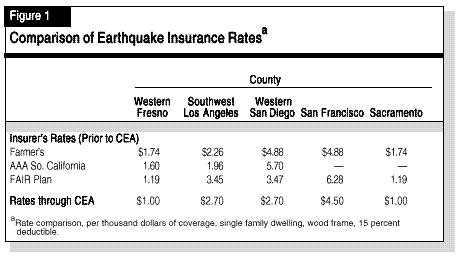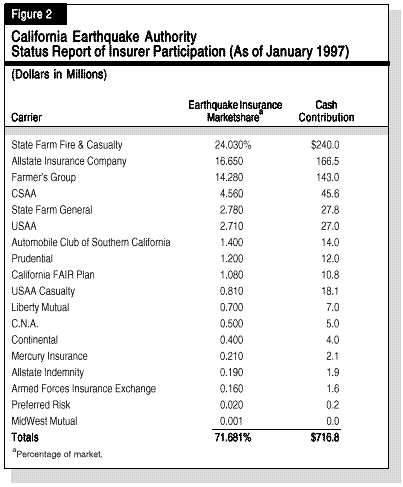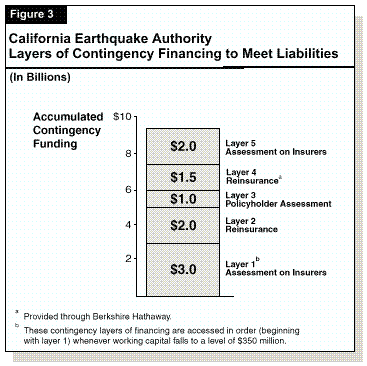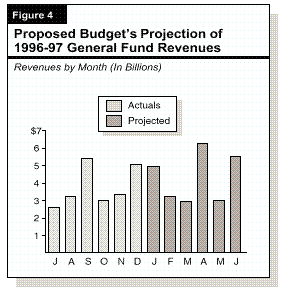

This California Update describes this new system and how it will operate.
Current law limits the operating expenses of the CEA to no more than 3 percent of the insurance premiums received by the CEA. At this time, the CEA expects premiums to total about $1.2 billion annually. On this basis, the CEA's operating budget could be up to $36 million annually. The CEA operating budget is not subject to state approval. The CEA, however, must submit an annual report to the Legislature and is subject to an annual audit by independent auditors approved by the state Department of Finance.
The CEA will be responsible for collecting the required initial cash contribution and insurance premium revenues from participating insurers, establishing rates, obtaining contingency funding, and the ongoing operations of the authority. The CEA is responsible for all claims payments under this program in the event of an earthquake. Its liability, however, is limited to the amount of funding available. In the event of a funding shortage, claims payments would be prorated. In no event does the state General Fund bear any liability for payments.
Individuals who already have earthquake insurance and whose insurance companies participate in the CEA program will have their earthquake coverage continued under the CEA program when it comes up for renewal. These insurance companies are required to send notices informing a policyholder that their earthquake insurance policy will be transferred to the CEA. Thus, the way an individual buys and receives earthquake insurance will not change under the CEA program. The only time an individual will deal with the CEA directly is if there is a dispute over claims.
Figure 1 compares the interim rate for a 15 percent deductible policy on a typical home located within various counties to the rates for the same coverage offered by three insurers before they joined the CEA. (Prior rates for the other 15 insurers participating in the CEA were not available from the Department of Insurance at the time this report was written. When the prior rates are available for these other insurers, it may be more clear what effect the CEA will have on earthquake insurance rates in California.) Based on this limited comparison, the CEA rates for this category of structure are generally lower than prior rates.

All insurers who participate in the CEA program will sell policies according to CEA rates. The rates include specific amounts (based on a percentage of each premium) that will be retained by the insurer to cover operating costs, compensation for agents selling CEA policies, and expenses associated with claims after an earthquake. All premium payments less the amount retained by the insurer will be transferred to the CEA.
To date, insurers representing approximately 72 percent of the market have agreed to participate. Figure 2 (see next page) provides a list of these insurers and their contributions.

The CEA can initially access a total of about $10.2 billion. The different sources of financing must be accessed in a sequential order for paying out earthquake claims. For example, working capital must be used first to pay earthquake claims, followed by the first layer of contingency financing, and so on. The amount used from each layer is dependent on the level of insurance claims and the requirement that the CEA maintain a minimum working capital of $350 million.
Working Capital. The first source of funds to pay claims is working capital—the $717 million cash contribution from the participating insurers plus accumulated premiums. Working capital must be maintained at no less than $350 million. That is, claims that would otherwise reduce working capital below this level have to instead be paid from the layers of contingency funding. (The federal tax status of the CEA is an important aspect of this layer of the CEA's capitalization. The Internal Revenue Service ruled that the CEA will be exempt from federal taxes. This is important because it allows the CEA to accumulate reserves more quickly than a private insurance company.)
There are five layers of contingency funding, including assessments on insurers and policyholders and forms of reinsurance. The assessments are one-time funding mechanisms—once the maximum funding for each layer is depleted, it cannot be accessed again. Figure 3 shows the sequence of the layers and the amount of funds that can be accessed under each layer if insurance claims reduce the CEA working capital to less than $350 million.

Layer 1: Assessment on Participating Insurers, $3 Billion. This layer of financing is an assessment of up to $3 billion on participating insurers. Insurers would be assessed based on their market share of earthquake insurance under the CEA program (similar to their initial contributions). After the CEA has been in operation for 12 years, this layer of financing is eliminated.
Layer 2: Reinsurance, $2 Billion. The CEA must obtain reinsurance contracts in an amount of at least 200 percent of the total initial cash contributions from participating insurers. To meet this requirement, the CEA has obtained a two-year contract for $2 billion in reinsurance. The cost of this contract is $148 million annually.
Layer 3: Assessment on Policyholders, $1 Billion. To obtain this financing, the State Treasurer is authorized to secure a "credit facility" and/or issue up to $1 billion in revenue bonds. The State Treasurer has opted to secure a line of credit which should be in place in January 1997. The CEA is authorized to levy an assessment on all policyholders to pay off the cost of obtaining this layer of financing. This assessment cannot exceed 20 percent of the annual earthquake insurance premium.
Layer 4: Reinsurance. The CEA may access any other private market for funding in this layer. Current law does not set a limit for the amount of funds raised from this source. The CEA governing board, however, has approved a reinsurance contract with Berkshire Hathaway Inc. to provide up to $1.5 billion under this layer of claims financing. This contract costs about $161 million annually for four years.
Layer 5: Assessment on Participating Insurers: $2 Billion. This layer is essentially the same as the second layer, except that while the first assessment is eliminated after 12 years, this assessment is gradually reduced once the CEA's available capital exceeds $6 billion. The amount of the reduction is limited to a maximum of 15 percent per year.
Accessing the Capital Layers for CEA Financing. The different capital sources would be accessed depending on the amount of claims resulting from an earthquake. For example, suppose the CEA had been in operation for one year and had $2 billion in working capital from the initial cash contribution and accumulated insurance premiums. If there were an earthquake that resulted in $4 billion in claims, the CEA would pay the claims as follows:
The budget's overall economic forecast is consistent with other economic projections made near the end of 1996, including the forecast made by our office in November (see California's Fiscal Outlook—The LAO's Economic and Budget Projections, 1996-97 Through 1998-99). The budget's estimate of personal income growth, however, is slightly higher than the consensus view.
Figure 4 shows actual monthly collections of General Fund revenues for July through December of 1996-97, along with the budget's projection for the remainder of the fiscal year. December receipts reflected growth in personal income taxes and sales and use taxes consistent with the economy's continued moderate economic expansion. Bank and corporation tax receipts, however, fell below the December 1995 level, raising some questions regarding the underlying strength in California taxable corporate profits.

January is expected to be a fairly large revenue month, with nearly $5 billion in collections projected. Partial-month data are thus far consistent with the projection for the month, but full-month data will not be available until early February.
We will be monitoring monthly revenue performance in future editions of California Update.
Contact -- Brad Williams -- (916) 324-4942.
Reports are also available on the LAO's World Wide Web page at http://www.lao.ca.gov. The Legislative Analyst's Office is located at 925 L Street, Suite 1000, Sacramento, CA 95814. |